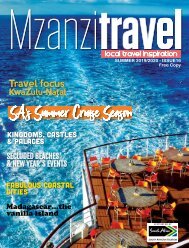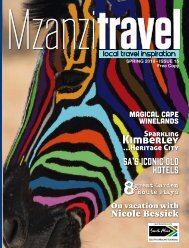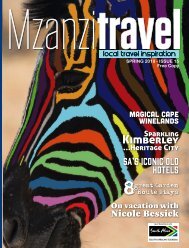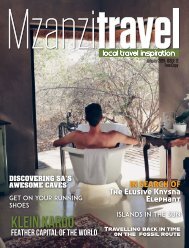MZANZI ISSUE 16
Create successful ePaper yourself
Turn your PDF publications into a flip-book with our unique Google optimized e-Paper software.
Heritage<br />
started long before Van Riebeeck and the Dutch arrived at the<br />
Cape of Good Hope.<br />
SA’s ancient royal houses<br />
When the Dutch arrived here, they found a social system<br />
among the Khoekhoen – one of the two main branches of<br />
the collectively named Khoisan or original inhabitants of the<br />
southwestern parts of Africa – consisting of a number of<br />
pastoral tribes or clans, each headed by a powerful chief or<br />
captain with his own ruling seat, known as a kraal.<br />
While the chief’s kraal – and his personal herd of sheep and<br />
cattle - reflected his status, power and wealth that set him<br />
apart from his fellow clansmen or followers, his kraal did not<br />
display anything like the extravagant opulence of European<br />
royal courts. Unfortunately no examples of such Khoekhoen<br />
chiefs’ kraals have survived and we can only guess what they<br />
must have looked like.<br />
However, as mentioned, other monarchical systems that existed<br />
among the tribes of Bantu-origin in South Africa back then,<br />
continue to this day in the form of seven kingdoms. Chapter<br />
11 of the Constitution of South Africa recognizes the role and<br />
status of traditional leadership according to customary law,<br />
but further legislation was later adopted that ‘democratised’<br />
the system, including requirements that 40% of the council<br />
must be elected, and one-third must be women.<br />
But these kings don’t live in the traditional Western idea of a<br />
castle or palace such as, for example, Buckingham Palace in<br />
the United Kingdom. However, receiving generous royal salaries<br />
and benefits from the state, they do live in relative luxury in<br />
their residences located at what are variously referred to as<br />
royal houses, royal kraals, great places or great palaces. Some<br />
of these can be visited, but most are private and closed to the<br />
public, although you can view them from nearby by visiting<br />
the areas where you will also find much else of interest.<br />
A panel of experts appointed by former President Thabo<br />
Mbeki in 2003, investigated traditional leadership disputes<br />
and claims dating back to 1927. The panel discovered that<br />
out of the 13 paramount kingships that existed then, only seve<br />
were qualified to be recognized as kingships or queenships.<br />
However, subsequently then president Jacob Zuma gave his<br />
assurance that those traditional leaders who were found to<br />
be illegitimate would not be dethroned, but that the title would<br />
come to an end on the death of the current incumbents.<br />
The seven officially recognised kingdoms/queenships that remain<br />
in South Africa, are :<br />
• King Zwelonke Sigcawu of the AmaXhosa (Eastern Cape)<br />
• King Goodwill Zwelithini of the AmaZulu (KwaZulu-Natal)<br />
• King Buyelekhaya Dalindyebo of the AbaThembu (Eastern<br />
Cape)<br />
• King Toni Mphephu Ramabulana of the VhaVenda<br />
(Limpopo) (currently being challenged for the throne by<br />
Princess Masindi Mphephu)<br />
• King Makhosonke Enoch Mabena of the AmaNdebele<br />
(Mpumalanga)<br />
• King Zanozuko Tyelovuyo Sigcau of the AmaMpondo<br />
(Eastern Cape)<br />
• King Thulare Victor Thulare of the Bapedi ba Maroteng<br />
(Limpopo)<br />
A king’s labyrinth defences<br />
King Mphephu of the VhaVenda, the tribe to which South<br />
African President Cyril Ramaphosa belongs, lives at his<br />
official residence, the House at Dzata, in Dzanani, Limpopo.<br />
Dzata is regarded as the spiritual home of the VhaVenda and<br />
is the ancient capital of Venda. Some years ago, the writer<br />
was honoured to visit the royal kraal of the current king’s<br />
predecessor, his half-brother King Tshimangadzo Dimbanyika<br />
Mphephu, who died in a car accident in 1997.<br />
One fascinating detail of that visit was a cliffside directly<br />
iStock-Bob Hilscher<br />
iStock-Bob Hilscher.
















